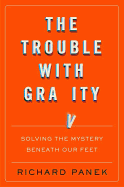
Gravity, to the layperson, is easy to explain: it's a force that keeps us on the ground while Earth rotates, and it's what keeps each planet in our solar system on its rotational path around the sun. That explains what gravity does; what gravity is, however, is a question that philosophers, mathematicians and scientists have been considering for two millennia. Are they any closer to an answer?
In The Trouble with Gravity, science writer Richard Panek (The 4% Universe) delivers an illuminating history of figuring out this elusive force. Early storytellers had no concept of gravity, but they sought to explain what kept humans down here on Earth while something different kept the gods up in the heavens. Seeking an explanation, philosophers Plato and Aristotle introduced logic, though they drew false conclusions. Advances in science and mathematics allowed Galileo, Copernicus and Newton to observe that the heavens aren't so different, and that the same unexplainable force exists throughout the universe. Natural philosophers insisted on replicable scientific experiments as evidence, such as those that successfully predicted the appearance of comets. Einstein's theory of relativity paved the way for gravitational waves; a decade later, thanks to quantum mechanics, mind-bending concepts like black holes emerged.
But do we really know what gravity is? Even as "our understanding of the working of the universe" has grown over time, gravity continues "to refuse to play well with others." It's both an amazingly weak force that we overcome simply by taking a step, and the unlikely force that keeps the entire universe in balance. Panek's thought-provoking look at gravity offers no easy answers but much to contemplate. --Frank Brasile, librarian

